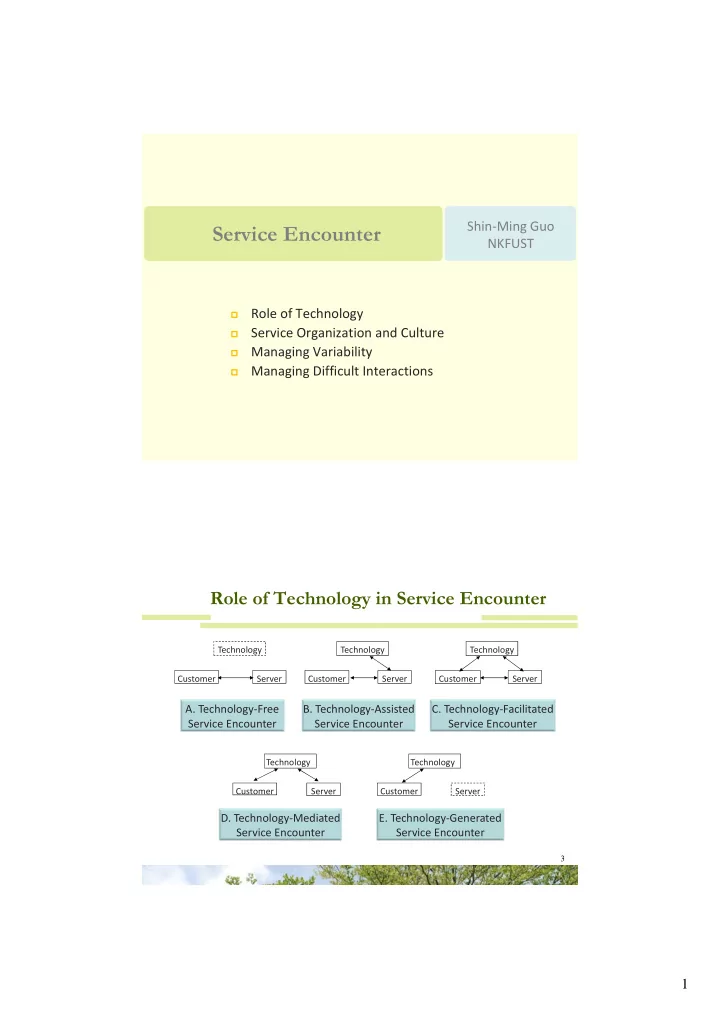

Shin ‐ Ming Guo Service Encounter NKFUST Role of Technology Service Organization and Culture Managing Variability Managing Difficult Interactions Role of Technology in Service Encounter Technology Technology Technology Customer Server Customer Server Customer Server A. Technology ‐ Free B. Technology ‐ Assisted C. Technology ‐ Facilitated Service Encounter Service Encounter Service Encounter Technology Technology Customer Server Customer Server D. Technology ‐ Mediated E. Technology ‐ Generated Service Encounter Service Encounter 3 1
Evolution of Service Encounter Service Human Machine Internet Industry Contact Assisted Facilitated Banking Teller ATM Online banking Grocery Checkout clerk Self ‐ checkout station Online order/ pickup Airlines Ticket agent Check ‐ in kiosk Print boarding pass Restaurants Wait person Vending machine Online order/ delivery Movie theater Ticket sale Kiosk ticketing Pay ‐ for ‐ view Book store Information Stock ‐ availability Online shopping clerk terminal Education Teacher Computer tutorial Distance learning Gambling Poker dealer Computer poker Online poker 4 The Service Encounter Triad Service Organization Efficiency Efficiency versus versus autonomy satisfaction Contact Customers Personnel Perceived control 5 2
I. Service Organization The service encounter occurs within the context of an organization’s culture as well as its physical surroundings. Employee Selection Training Control + Empowerment Strategy + Culture 6 Definitions of Corporate Culture • Culture is a pattern of beliefs and expectations shared by the organization’s members. • Culture is the traditions and beliefs of an organization that distinguish it from others. • Culture is shared orientations that hold the unit together and give a distinctive identity. 3
Countdown Ritz-Carlton Hotel- The Seven Day • Day One: Staff Orientation – Warm welcome, Philosophy, Gold Standards,… • Day Two: Departmental Vision Sessions – Group work, understand working purpose,… • Day Three through Seven: Skills Training – Daily line ‐ up, uniform fittings, handling guest difficulties, technical training,… II. Contact Personnel Selection 1. Abstract Questioning 2. Situational Vignette 3. Role Playing Training Unrealistic customer expectations Unexpected service failure 9 4
Example: Amy’s Ice Cream What was your most rewarding past experience and why? What are you looking for in your next job? What have you done in the past to irritate a customer? What flavor of ice cream best describes your personality? 10 Empowerment and Training Train and trust the inherent power within employees to evaluate choices and competently execute creative decisions. 1. Invest in people as much as in machines. 2. Use technology to support contact personnel rather than to monitor or replace them. 3. Consider the recruitment and training of contact personnel as critical to the firm’s success. 4. Link compensation to performance for employees at all levels. 11 5
Unethical Behaviors of Employees Misrepresenting the Customer Manipulation General Honesty and Nature of the Service Integrity • Promising a • Giving away a • Treating customers nonsmoking room when guaranteed reservation unfairly or rudely none is available • Performing • Being unresponsive to • Using bait ‐ and ‐ switch unnecessary services customer requests tactics • Padding a bill with • Failing to follow stated • Creating a false need for hidden charges company policies service • Hiding damage to • Stealing customer • Misrepresenting the customer possessions credit card credentials of the information service provider • Making it difficult to invoke a service • Sharing customer • Exaggerating the benefits of a specific guarantee information with third service offering parties 12 III. The Customer Unrealistic customer expectations 1. Unreasonable demands 2. Demands against policies 3. Unacceptable treatment of employees 4. Drunkenness 5. Breaking of societal norms 6. Special ‐ needs customers Unexpected service failure 1. Unavailable service 2. Slow performance 3. Unacceptable service 13 6
Managing Customer-Introduced Variability A trade ‐ off between cost and service quality (customer satisfaction) 14 Managing Customer-Introduced Variability 15 7
The Customer is Not Always Right Southwest managers tell employees they are Southwest's No. 1 customer, that the paying customer is not always right. Thinking the paying customer is right all the time, Southwest executives say, only undermines the trust between management and employees. "The theory goes that if we treat our employees well, they'll treat the customer well," a Southwest executive said. And that translates, most of the time anyway, into profits. Washington Post April 08, 2003 16 Southwest Tops All Airlines in Customer Service The University of Michigan’s Ross School of Business in partnership with the American Society for Quality and CFI Group announced the results of their American Customer Satisfaction Index (ACSI)—an annual customer service study—and Southwest Airlines had the best score among all airlines for the 16th consecutive year. “Southwest appears well prepared for today’s economic conditions with its no ‐ frills approach, low fares, and reliable service,” said Claes Fornell, founder of the ACSI. “The airline has a record of being able to deliver the basics well—getting both passengers and their luggage to the same destination on time.” 17 8
Service Encounter Success Factors Service Provider Human Machine Human Employee selection Intuitive interface Interpersonal skills Verification Support technology Security Customer Engender trust Easy to access Easy to access Compatibility Fast response Tracking Machine Verification Verification Remote monitoring Security Failsafe 18 Satisfaction Mirror More Repeat More Familiarity with Customer Purchases Needs and Ways of Meeting Them Stronger Tendency to Greater Opportunity for Complain about Service Recovery from Errors Errors Higher Customer Higher Employee Satisfaction Satisfaction Lower Costs Higher Productivity Better Results Improved Quality of Service 9
Summary Service encounter is viewed as a triad. Select and empower the contact personnel. Training to anticipate possible situations. The Customer is Not Always Right. New area: machines serving human customers 20 10
Recommend
More recommend